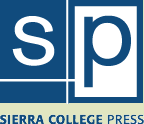Charlie Chaplin and The Gold Rush
Eighty years ago, Nevada County was the center of the entertainment universe. And it was all because of a Little Tramp.
In 1924, Charles Chaplin and his beloved tramp character filmed scenes from his silent movie classic “The Gold Rush” in and near Truckee. “The Gold Rush” is acclaimed as one of the best and most influential films ever produced. In 1998, the American Film Institute chose “The Gold Rush” as one of the 100 greatest films ever made. Chaplin referred to the film as “the picture that I want to be remembered by.” It was the highest grossing silent-era film comedy. The famous scenes of the Little Tramp eating a boiled shoe, battling with a teetering cabin that is seesawing on the edge of a cliff, and performing a remarkable dance using two forks stuck into bread rolls remain among cinema’s most indelible images.
Tops in Popularity & Pay
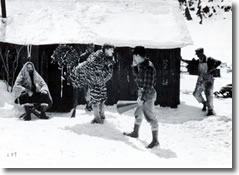 By 1924, Charlie Chaplin was the most famous entertainer in the world and, arguably, the most famous person in the world … period. He was also the highest paid actor. In 1916, his contract called for a paycheck of $10,000 a week (in today’s purchasing power, that would be about $175,000 weekly), but, by 1924, with his popularity at its zenith, no studio could afford him. Along with partners Douglas Fairbanks and Mary Pickford, two of the most popular film stars of the era, Chaplin founded United Artists in 1919 to independently make and distribute their own films. The distribution contract called for Chaplin to receive 50% of the profits from his movies and retention of their copyrights after a few years.
By 1924, Charlie Chaplin was the most famous entertainer in the world and, arguably, the most famous person in the world … period. He was also the highest paid actor. In 1916, his contract called for a paycheck of $10,000 a week (in today’s purchasing power, that would be about $175,000 weekly), but, by 1924, with his popularity at its zenith, no studio could afford him. Along with partners Douglas Fairbanks and Mary Pickford, two of the most popular film stars of the era, Chaplin founded United Artists in 1919 to independently make and distribute their own films. The distribution contract called for Chaplin to receive 50% of the profits from his movies and retention of their copyrights after a few years.
Chaplin was fascinated with the story of the Donner Party and he endeavored to develop a movie that built upon the themes of enduring great hardships in pursuit of immense riches or a better life. He chose Alaska’s Yukon Gold Rush of 1898 as his setting.
"Rollie" Totheroh, Cinematographer
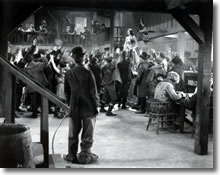 Chaplin’s “The Gold Rush” followed his usual pattern of production—there was a basic outline of the story but there was not an actual script. Chaplin had utilized the same filmmaking methods for years, a mixture of skeletal story and constant experimentation and retakes. Roland H. “Rollie” Totheroh was Chaplin’s cinematographer on The Gold Rush. Totheroh was the primary cameraman on virtually all Chaplin’s pictures throughout the Little Tramp’s career. Chaplin usually used only one camera and would ultimately produce more than 230,000 feet of film—almost 43 hours of film. However, several cameras were used to film the opening sequence of the movie. The final film would be 1½ hours long. The motion picture took seventeen months to complete. Most films in those years were completed in less than 30 days. It cost $923,886—the most expensive comedy of the entire silent-film era.
Chaplin’s “The Gold Rush” followed his usual pattern of production—there was a basic outline of the story but there was not an actual script. Chaplin had utilized the same filmmaking methods for years, a mixture of skeletal story and constant experimentation and retakes. Roland H. “Rollie” Totheroh was Chaplin’s cinematographer on The Gold Rush. Totheroh was the primary cameraman on virtually all Chaplin’s pictures throughout the Little Tramp’s career. Chaplin usually used only one camera and would ultimately produce more than 230,000 feet of film—almost 43 hours of film. However, several cameras were used to film the opening sequence of the movie. The final film would be 1½ hours long. The motion picture took seventeen months to complete. Most films in those years were completed in less than 30 days. It cost $923,886—the most expensive comedy of the entire silent-film era.
“The Gold Rush” was revolutionary in placing film comedy in the context of an actual historical event. And Chaplin decided to enhance the historic authenticity by filming on location. Location filming was not a new idea, but the scope of the location filming for “The Gold Rush” was unprecedented. Charlie chose Truckee as the ideal location to recreate the famous trail that led into the Yukon—the Chilkoot Pass. Chaplin intended to film the exterior scenes of the film exclusively in Truckee.
Truckee 1924
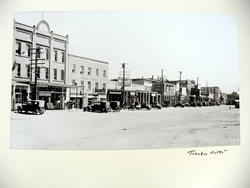 Truckee had been used a number of times prior to 1924 as an outdoor location by the famous film comedian Buster Keaton. Chaplin and Keaton were close friends and Chaplin was well aware of Truckee’s desirability as a location. Given his interest in the Donner Party and his personal knowledge, it is not surprising that Chaplin decided to use Truckee. Filming began in February 1924, and lasted until April 28 of that year.
Truckee had been used a number of times prior to 1924 as an outdoor location by the famous film comedian Buster Keaton. Chaplin and Keaton were close friends and Chaplin was well aware of Truckee’s desirability as a location. Given his interest in the Donner Party and his personal knowledge, it is not surprising that Chaplin decided to use Truckee. Filming began in February 1924, and lasted until April 28 of that year.
Chaplin restaged the snow-covered Chilkoot Pass for the film’s opening sequence. In the scene, hundreds of desperate miners struggle to climb the steep, narrow path that reaches through the pass and to the Yukon Territory. In order to provide the requisite accuracy, a ridge near Donner Summit in today’s Sugar Bowl Ski Resort was used. The Truckee Ski Club cleared a path for the single-file trail that led over the pass. Chaplin arranged for six hundred men to be brought by train from Sacramento to serve as extras. The scene was shot entirely in one day and remains what film critic Jeffrey Vance calls “the most spectacular image of silent-film comedy.”
Bitter Sierra Weather
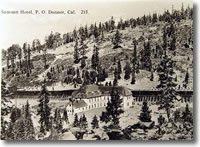 Chaplin had planned to film extensively in Truckee and in parts of nearby Placer County. Where they lodged is somewhat open to question. Some accounts indicate that Chaplin and his crew may have set up residence in the Swedish House Hotel downtown. Today, the Swedish House is a bed-and-breakfast called the East River Inn. More likely, they stayed at the Summit Hotel near Donner Summit to be closer to the filming locations. Wherever they finally settled, they expected to stay for quite awhile.
Chaplin had planned to film extensively in Truckee and in parts of nearby Placer County. Where they lodged is somewhat open to question. Some accounts indicate that Chaplin and his crew may have set up residence in the Swedish House Hotel downtown. Today, the Swedish House is a bed-and-breakfast called the East River Inn. More likely, they stayed at the Summit Hotel near Donner Summit to be closer to the filming locations. Wherever they finally settled, they expected to stay for quite awhile.
However, the Sierra winter weather turned nasty and bitterly cold. Many crew members and extras came down with colds and Chaplin contracted influenza. After attempting to film in the difficult conditions and exposing thousands of feet of film, Chaplin decided to suspend filming in Truckee and concentrate on using controllable (and, undoubtedly, warmer) studio sets. Much of the Truckee and Placer County footage ended up on the cutting room floor. Other than the Chilkoot Pass sequence, only one other scene in the final cut of the movie was filmed near Truckee—a scene in which the Little Tramp slides down a snowy slope.
The final scenes for “The Gold Rush” would be completed in May 1925. On June 26, 1925, “The Gold Rush” lavishly premiered at Hollywood’s Egyptian Theatre. Interestingly, the theater owner, Sid Grauman (who would become renowned as the owner of Grauman’s Chinese Theatre where movie star shoeprints are permanently displayed in the concrete sidewalks) had participated in a gold rush and traveled to Truckee to serve as an advisor to Chaplin. 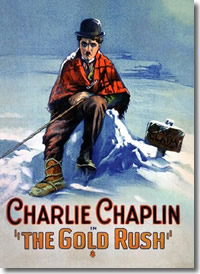
Profitable Gold Rush
The film opened to wide acclaim … and great profit. “The Gold Rush” would gross $6 million.
In Truckee today, a giant reproduction of Chaplin’s Little Tramp is painted on the side of the Capital Theater, a fitting reminder of the winter eight decades ago when one of the most famous people in the world made Nevada County his base of operations.
Movie clips from "The Gold Rush" are available on YouTube.Here are scenes from the movie shot by Rollie Totheroh in the snow. (.mov)
Chaplin – Totheroh – Image Credits: All images from Chaplin Archives, Switzerland
